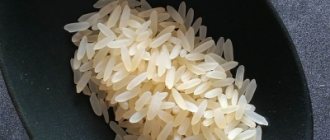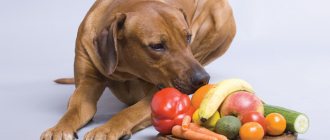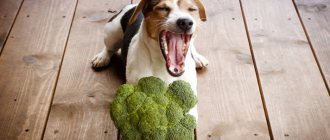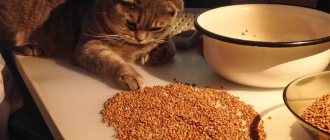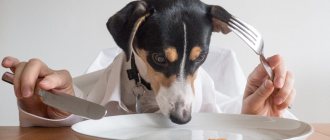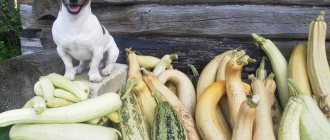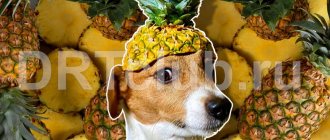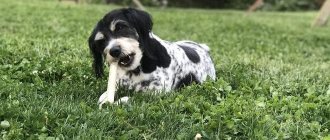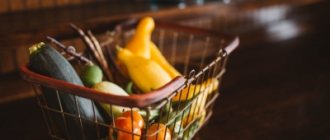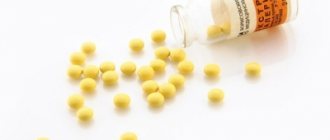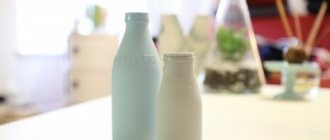The choice between industrial food and preparing food for your pet yourself depends solely on its owner. When choosing natural food, it is important to carefully select cereals for dogs. Not all of them are suitable for the digestive system of animals. At best, such nutrition simply will not bring any benefit, and at worst, it will cause serious gastrointestinal diseases. You can avoid harming your pet with a selected diet by thoroughly studying the properties and compatibility of various cereals.
The benefits and harms of cereals
Conventionally, dog food is divided into 2 types: industrially produced and homemade. Both options have both pros and cons. Proponents of home cooking for dogs highlight several compelling arguments in its favor:
- Fast weight gain. Properly prepared natural food for dogs promotes the growth of missing muscle mass, without the risk of obesity. But this does not mean that the animal can be fed exclusively carbohydrates. It is necessary to cook porridge for your pet in certain proportions. In addition to maintaining a balance of cereals and protein, you need to additionally provide a complex of vitamins and minerals.
Expert opinion
Anna Abramenko
An avid dog lover. Experience in veterinary medicine since 2009.
Ask a Question
Weight loss in an animal may be due to health problems or parasites. Consultation with a veterinarian is necessary to rule out these possibilities.
- Improving the condition of the coat. With a balanced diet, which includes various types of cereals, the quality of dogs' hair and teeth significantly improves. Thanks to carbohydrates, their coat acquires shine and a uniform structure.
- Energy charge. Owners of different breeds note that if you give porridge to dogs, they become more active and cope better with physical activity. Some types of cereals are rich in vitamins and microelements necessary for the full development of the animal. Balanced cereals are a source of carbohydrates, many of them contain protein. This unique composition provides the dog’s body with the necessary energy.
- Natural colon cleansing. Included in most cereals, fiber normalizes the functions of the large intestine. By adding several types of cereals to the diet, the functioning of the dog’s digestive system significantly improves.
Despite the abundance of positive actions, giving an animal exclusively plant food is unacceptable. High-quality food prepared at home should contain amino acids and a significant amount of protein. Therefore, in addition to cereals, recipes for various porridges contain meat, offal and sea fish.
Expert opinion
Anna Abramenko
An avid dog lover. Experience in veterinary medicine since 2009.
Ask a Question
The statement about the dangers of plant components is only partly true. Some types of cereals are really not suitable for dogs. Their health is also negatively affected by the low meat content in prepared food and individual intolerance to some type of cereal. In any case, if you notice a deterioration in the dog’s condition after eating porridge, the diet needs to be reconsidered.
What to do if you vomit after it?
If after eating semolina porridge (or in any other case) the dog vomits, it is necessary to provide it with first aid.
- Ensure rest - try to put your pet down and cover with a blanket if he is shaking.
- Encourage and calm the pet - he should feel cared for and needed; Under no circumstances should you allow yourself to worry or feel guilty.
- the soiled fur with a rag or towel soaked in warm water - carry out the procedure only when the dog is calm; if the animal feels uncomfortable, it is better to wait a little.
- Place disposable diapers or unnecessary towels in case of repeated vomiting.
- Carefully monitor the animal for signs of impending vomiting or deterioration of the condition - these include gagging, stiffness, immobility, prolonged aimless walking around the room.
If the pet's condition has returned to normal and vomiting does not recur, it is recommended to give the pet a rest. In addition, for the first time after vomiting you will have to adhere to some nutritional recommendations.
- It is not advisable to feed the animal for 12 (8-10 for young dogs and puppies) hours after vomiting, so as not to provoke repeated attacks and not to overload the irritated stomach.
- Solder with water - every hour you need to give 2 tsp per 1 kg of weight. Give water until the dog starts drinking on its own. Also, you can give a rehydron solution (according to the instructions), according to the same scheme as water.
- If your pet refuses to drink, you need to wipe its gums with a napkin/rag soaked in water . You can also try giving ice cubes or warm herbal tea (chamomile, ginger, mint).
- After 12 (8-10) hours, you need to start giving light, easily digestible food - boiled potatoes, boiled skinless chicken, beef cutlet, boiled rice or pressed cottage cheese. Give food 2-3 tsp. each hour.
- Follow this dietary diet for 24 hours , then carefully begin to introduce regular food - mix dietary and regular food in equal proportions for the first feeding, then, with each feeding, gradually reduce the proportion of dietary food.
- Under no circumstances should you give any medications without the permission of your veterinarian.
It is worth understanding that vomiting can be caused not only by poorly prepared or poor-quality food, but also be a symptom of various serious pathologies.
Therefore, if the following signs are detected, it is urgent to show the animal to a specialist:
- pale skin and gums;
- atypical behavior, depression;
- weakness, loss of strength;
- difficulty walking or standing up;
- problem raising the head;
- repeated or recurring vomiting, inability to retain water.
In addition, if your dog has any chronic diseases, you should also consult with a specialist before restricting its food.
What cereals can you feed your dog?
Not all grains are recommended for dogs as food on an ongoing basis. Some should be treated with caution, due to possible allergic reactions or individual intolerance.
- Rice porridge is suitable for daily consumption by all breeds of dogs. It contains vitamins E and group B, as well as zinc, iron, magnesium, and potassium. In addition to the undoubted benefits of microelements, rice has an absorbent effect. Its decoction will help with a dog's stomach upset, diarrhea and poisoning.
Expert opinion
Anna Abramenko
An avid dog lover. Experience in veterinary medicine since 2009.
Ask a Question
Preference should be given to unpolished types of rice; they contain more protein and lipids. This type of cereal contains less starch and is easier to digest, it does not contain gluten, and it is considered hypoallergenic.
Excessive consumption of rice cereal by a dog can cause constipation. You can avoid this by combining several cereals.
- Buckwheat porridge is rich in iron and magnesium, vitamins B and E and other microelements. It is easily digestible and suitable for large breeds or sedentary dogs. Regular consumption of buckwheat speeds up metabolism and strengthens the immune system. For animals with problems with the cardiovascular system, it is necessary to introduce it into the diet. This porridge is recommended to be given to puppies and pregnant dogs.
- Wheat porridge is considered a natural scrub for the intestines. Due to incompletely digested particles, it removes food debris from the walls. The starch content makes it contraindicated for dogs prone to gaining excess weight.
- Yachka combines high nutritional content and economical efficiency. Barley contains silicon and fluorine. But the amount of microelements is low, insufficient for complete nutrition of a healthy dog. Yachka is not suitable for the daily diet.
- Oatmeal often causes allergic reactions, so it should be administered with caution. It is recommended to start feeding your dog oatmeal with small portions and carefully monitor its condition. The reaction is expressed in intense scratching of various parts of the body, redness and rashes. You should also use oats, not rolled oats.
When preparing natural food, it is recommended to mix different types of cereals. This will expand the list of vitamins and microelements in their composition. You should not give preference to any one of the porridges; a dog’s complete diet requires variety.
?
conclusions
What grains can be cooked for dogs? Porridge with meat or fish plus vitamin supplements is great for all age groups and dog breeds. Not all cereals are equally healthy. Wheat and barley groats are allergenic. They contain a lot of gluten. Corn is used only as an additive at a level of 10-15%. Rice, buckwheat and millet (use only in properly prepared form) are hypoallergenic. If we talk about what kind of cereal a puppy can eat, then it’s better to limit it to rice. The share of cereals is on average 30% of the diet. Peas and other legumes are not suitable for feeding dogs. Semolina is used for puppies at the initial stage of complementary feeding and in the treatment of adult dogs.
Please follow and like us:
Nikitin Sergey
I write about dogs based on the experience and knowledge gained during my studies as a veterinarian, work in my specialty, and simply from observing my pets.
What cereals are prohibited
Not all grains are good for a dog's body. Some cause severe allergic reactions or are not absorbed by the digestive system. The following porridges are prohibited:
- Barley is rich in vitamins and microelements, but the dog’s body is not able to absorb them, which makes eating this porridge absolutely useless. Pearl barley is produced by grinding the barley; this greatly complicates its digestion and ultimately leads to constipation.
- Millet porridge is a product that causes allergic reactions. In addition, millet is difficult to digest and its energy value is not beneficial.
- Corn grits can cause a false feeling of fullness in your pet. Corn also contributes to the development of various gastrointestinal diseases and allergies.
- Semolina porridge contains fast carbohydrates. This feature of the composition leads to a sharp weight gain in animals. Its use may be due to dystrophy or slow growth in puppies. In other cases, including semolina in the diet will not be beneficial, especially for dogs with diabetes.
For animals
Buckwheat is rich in iron, magnesium, carbohydrates and vegetable protein, as well as B vitamins, and is not just good for dogs, but is one of the favorites of allowed cereals. This is what you should cook for your pet more than anyone else. This cereal can and should be given to the dog, not forgetting that the diet should consist of 35% cereals and 65% other food.
Allergy
Attention! Most often, dogs are not allergic to buckwheat, but the opposite happens. There is nothing supernatural about this, because just like all people, all dogs are different and some may be allergic to certain foods. It is worth observing your pet immediately after the first use. If the condition after eating is positive, buckwheat can be safely included in the diet.
Cooking at home
You can get the maximum benefit from natural nutrition only if the food is fresh. Meat broths should not be stored for more than two days. Most porridges lose their taste after cooling and are more difficult to digest. Therefore, regardless of the type of cereal, it is better to prepare meat porridge for your dog immediately before consumption. You should also pay attention to the following recommendations:
- You can improve the properties of buckwheat by soaking it for 20 minutes in cold water before cooking;
- polished rice or eggs stick together less when adding a small amount of vegetable oil;
- oats can be added to the main grain; 2-3 spoons are enough per serving;
- porridge with milk is poorly digestible; water or meat broth will replace it;
- You cannot give raw meat and ready-made porridge at the same time, this will cause fermentation in the dog’s stomach;
- The animal's food container must have a hermetically sealed lid.
Compliance with the standards for storing and preparing natural food for dogs will prevent the loss of microelements and will delight your pet with excellent taste.
Popular recipes
If you have any difficulties on how to cook porridge for your dog, the following recipes will help.
Monocasha
Ingredients:
- 150 g each of buckwheat and rice;
- 1 medium carrot and 1 large potato;
- chicken soup set.
Preparation:
- water is poured into the pan and meat by-products are placed;
- after the water boils, add the cereal;
- 20 minutes before readiness, add diced vegetables.
Vegetable
Ingredients:
- 1 glass of buckwheat;
- carrots – 1 pc.;
- cauliflower – 3 – 5 inflorescences;
- potatoes – 1 pc.;
- greens - parsley, dill, lettuce.
Preparation:
- vegetables are boiled for 15 - 20 minutes and removed from the water;
- add buckwheat to the remaining vegetable broth and simmer until tender;
- 10 - 15 minutes before readiness, add chopped potatoes, carrots and cauliflower;
- mixed with any meat and herbs;
- if desired, season with olive oil.
From rice and meat
Ingredients:
- 300 g turkey, chicken or veal;
- 400 g brown rice;
- 2 cups of any grated vegetables;
- 2 tbsp. l. vegetable oil.
Preparation:
- Boil the rice to a viscous consistency;
- cool the porridge and mix it with chopped meat and grated vegetables;
- fill with oil.
These are just a few porridge recipes for dogs. The owner can mix any permitted products, based on the pet’s taste and his own discretion. The main thing is to maintain the proportions of meat, cereals and vegetables.
Often, when switching from ready-made food to natural food, the dog does not eat porridge. To accustom her, they resort to tricks. Something aromatic is added to the dish: broth, canned food, treats. Gradually, the pet will get used to the new taste and will be willing to eat.
Approximate diet
The daily menu for a dog with average physical activity and weighing about 20 kg includes 2 meals:
- for breakfast, raw chicken necks (300 g) combined with vegetable oil (0.5 teaspoon);
- for dinner buckwheat porridge (100 g) with beef (200 g) zucchini (50 g).
Meat can be replaced with sea fish or poultry. In between main meals, you can give your pet a few pieces of vegetables or fruits.
This is interesting: The benefits of vegetables and fruits for dogs
Products that go with buckwheat
Additives to cereals are agreed with the veterinarian.
Dogs usually eat buckwheat:
- Meat. An essential component in a dog's diet. They don't give you minced meat, but finely chopped pieces. Pork or offal is subjected to heat treatment.
- Milk. Goat is healthier: it is less likely to cause allergies.
- Vegetables. Raw carrots, beets, pumpkin, and cabbage are added to the porridge. The additive should not exceed 1/3 of the weight of the entire serving. Vegetables can be stewed, but some of the vitamins are destroyed in this case.
- Flax-seed. The supplement is rich in microelements. Give it a little at a time: 1 tsp. divided into 3 days.
- Bran. A pinch of product is enough for one serving.
You should not pamper your pet with spices, bread, sweets, pasta and baked goods. This is all harmful to the dog. Excessive addition of fats causes problems with the liver and blood vessels, and excess weight appears.
Recommendations
The following rules and tips will help keep your dog healthy on natural food:
- the consistency of the porridge should not be very thick, ideally it is close to sour cream;
- your dog can be given chicken or quail eggs, both raw and boiled;
- Adding bran to porridge will help improve intestinal microflora and speed up metabolism;
- You should not remove raw bones from the menu, they are a source of phosphorus and calcium;
- Vitamins and minerals are found in large quantities in vegetables; they can only be given to your pet raw in the intervals between feedings;
- fish must be thoroughly cleaned of bones and avoid freshly caught fish; they often contain parasites;
- Do not combine fermented milk products with fresh herbs, vegetables or fruits;
- raw meat, if given separately from cereals, does not need heat treatment.
Natural dog food based on various cereals is considered the most natural and environmentally friendly. It is important to cook such porridges correctly and select ingredients in accordance with the size and breed of the animal. The main indicator of the right course will be the condition of the pet’s coat, teeth and eyes, its muscle tone, and physical activity.
How to cook
Porridge is given to your pet fresh; it cannot be stored in the refrigerator for a long time. Before feeding, the finished dish is diluted with broth or vegetables and meat are added. Buckwheat should be cooked without adding salt or any seasonings.
If the grain is dirty, it is sorted out, removing debris. If moth larvae are found in buckwheat, then the cereal is thrown away, otherwise a dish made from such a product can provoke allergies and poisoning.
Porridge recipe
The porridge should be fluffy and boiled. Before cooking, the required volume of cereal is poured with water. After half an hour, the liquid and all the floating grains are drained. The soaked buckwheat is cooked until the liquid has completely boiled away, the pan is wrapped in a warm blanket and left to steep.
You need to take 1 measuring cup of cereal and 2-2.5 liquids. You can cook porridge with water or broth. In the second case, the broth is prepared separately, and cereal is added to the strained broth.
In the process of cooking offal, you need to remove the resulting foam . With broth, the porridge turns out to be more nutritious and satisfying.
Buckwheat in milk for puppies is diluted 1:4. You can cook it in 30 minutes over low heat.
Milk porridge
Milk causes bloating, so you should consult your veterinarian before consuming this product. If you are lactose intolerant, an additional symptom is an allergic reaction.
The dog may vomit and the animal may develop diarrhea. Volvulus is often associated with the consumption of milk buckwheat porridge.
Puppies are allowed to try the product under the supervision of a veterinarian. In case of allergies, buckwheat food is removed from the diet. Milk porridge is contraindicated for adult dogs. Kefir and cottage cheese are good for them.
